See Neptune Through Telescope
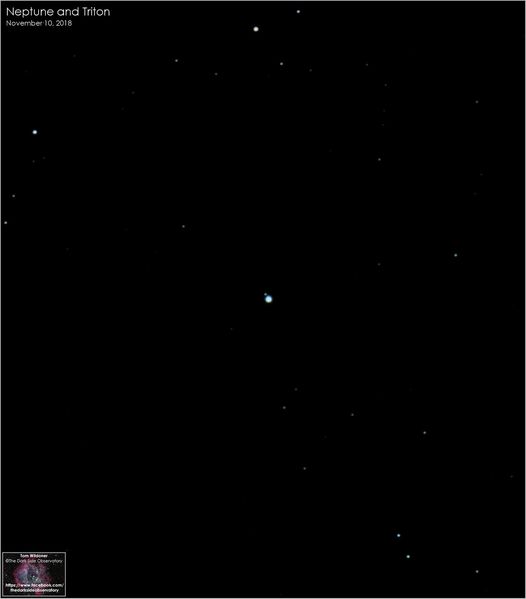
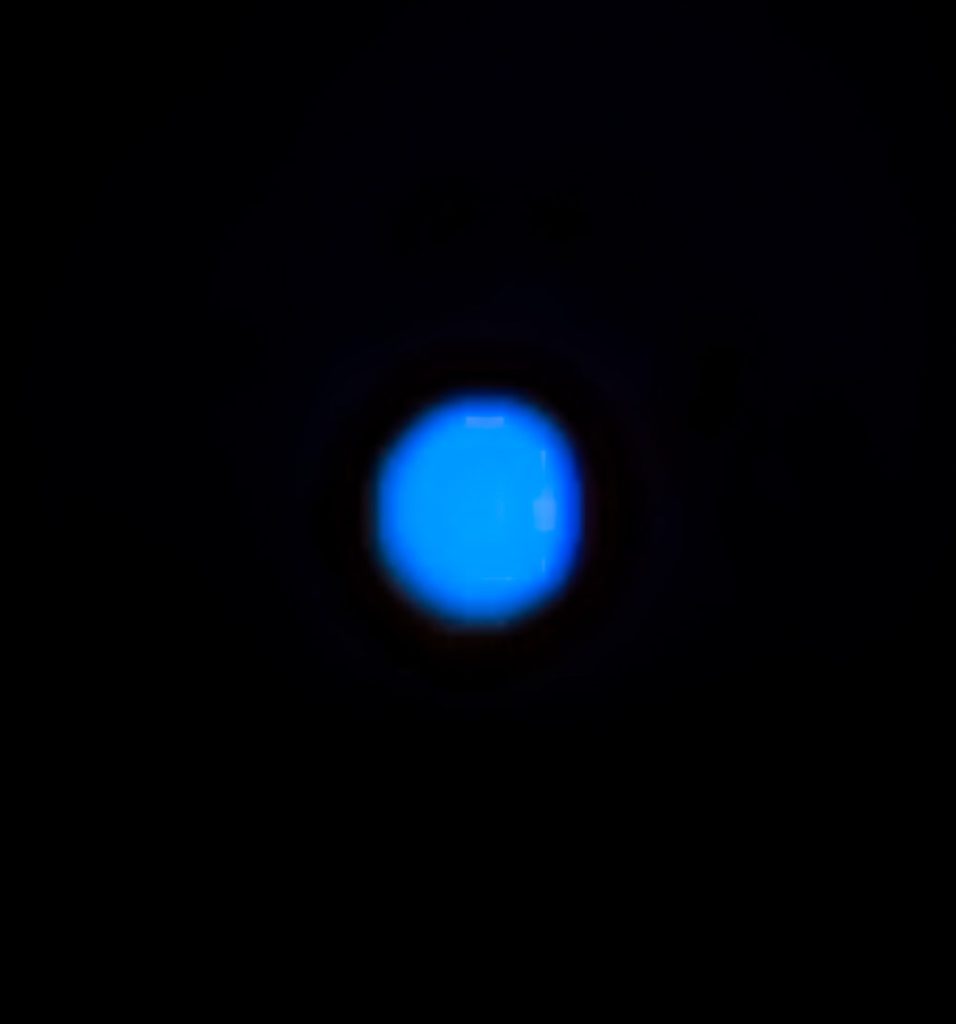
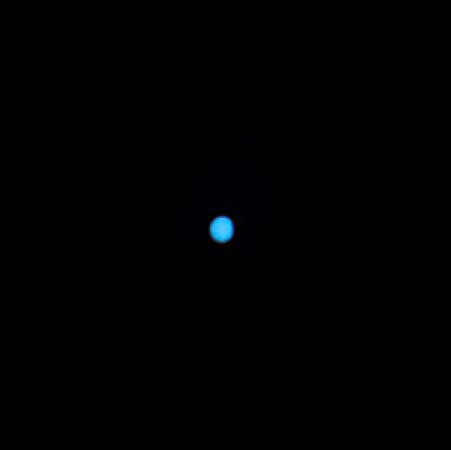
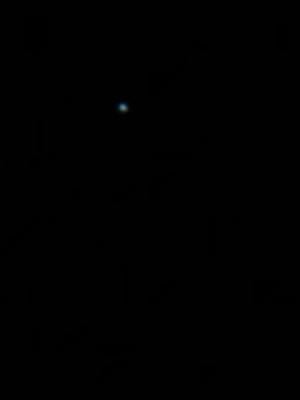
Neptune is the eighth and farthest known planet from the Sun. Neptune can be seen through a telescope. Telescope with an aperture of at least 8 inches (20 cm) and a magnification between 100-200x is recommended to achieve the best view of Neptune. Neptune appears as a small, blue-green dot or disk when viewed through a telescope. Its size and visibility are significantly influenced by its vast distance from Earth, making it appear quite small and faint compared to brighter and closer planets.
With larger telescopes (12 inches or more) and under optimal conditions, intriguing details such as cloud bands and Neptune’s faint ring system can be observed. Amateur astronomers are able to see Neptune’s largest moon, Triton, as a faint point of light near the planet. Capturing detailed images of Neptune and its moons is challenge for amateurs.
When viewed through a moderate-sized telescope, Neptune appears as a tiny bluish-green disk, with a distinct pale blue color caused by the absorption of red light and the scattering of blue and green wavelengths by methane and ammonia ices in its atmosphere. Its apparent size is about 2.4 arcseconds, and its distant location (over 2.8 billion miles away) makes it challenging to observe surface details.
The best telescope to see Neptune is a high-quality refractor or reflector telescope with an aperture of at least 8 inches (20 cm). Larger apertures allow for better resolution and detail, making it easier to observe Neptune’s small, faint appearance. Reflector telescopes, such as Newtonian reflectors, are popular for planetary viewing due to their larger apertures and reasonable pricing.
Plan your observation during Neptune’s opposition, which occurs every 16.1 months, for the brightest and closest view. Choose a dark location with minimal light pollution and a clear, moonless night with good seeing conditions. Use star charts or planetarium software to find Neptune’s current position in the sky. Start with a low magnification (100-150x) and gradually increase to focus on Neptune and observe its details. Enhance the contrast and visibility of Neptune’s atmosphere by using a blue or violet filter. Observe Neptune over several nights to notice its movement relative to the background stars. Consider using a telescope with a motorized drive or tracking system to compensate for Earth’s rotation and keep Neptune in view.
Can you see Neptune with a telescope?
Yes, you can see Neptune with a telescope. Use telescope with an aperture of at least 8 inches (20 cm) and a magnification between 100-200x to achieve the best view of Neptune. Neptune appears as a small, blue-green dot or disk when seen through a telescope.
Neptune’s size and visibility are influenced by its vast distance from Earth. Neptune appears quite small and faint compared to brighter planets closer to our home planet. It is possible to see Neptune and some of its features with the right equipment and excellent viewing conditions. Larger telescopes, with a diameter of 12 inches or more, can reveal intriguing details such as cloud bands and Neptune’s faint ring system under optimal conditions.
Amateur astronomers are able to see Neptune’s largest moon, Triton. Triton is visible as a faint point of light near Neptune with a decent-sized telescope and under dark skies.
Can you see Neptune at night without a telescope?
Neptune cannot be seen from Earth with the naked eye due to its extreme distance and low brightness. This celestial body is too faint to be seen without the aid of a telescope or binoculars, even on the clearest of nights.
The reason for Neptune’s invisibility to the unaided eye lies in its apparent magnitude, which is around 7.8. This measurement indicates the brightness of a celestial object as seen from Earth. Objects with a higher magnitude appear dimmer, and those with a magnitude above 6 are invisible to the naked eye. One would require at least binoculars or a telescope to detect Neptune.
Why is it not possible to see Neptune without using a telescope?
Neptune’s average distance from Earth is about 4.5 billion kilometers (2.8 billion miles). This vast distance makes it extremely challenging for backyard stargazers to spot with the naked eye. Its remote location in the solar system means that very little sunlight reaches it, making it appear as a faint point of light in our sky.
Neptune has a visual magnitude around +7.8 to +8. Visual magnitude is a measure of an object’s brightness as seen from Earth. The lower the magnitude, the brighter the object. Neptune, with its magnitude of +7.8 to +8, is about 100 times too faint to be seen without the aid of a telescope.
Neptune’s angular diameter is about 2.3 arcseconds. Angular diameter is the angle subtended by the planet at the observer’s eye. The minimum angular resolution of the human eye is around 20-30 arcseconds. Neptune would be difficult to resolve as a disk rather than a point source, even if it were bright enough.
You need at least a small telescope or a pair of high-powered binoculars to see Neptune. Optical equipment is required to bring Neptune into view. Neptune will appear as a tiny bluish disk with a telescope. Surface details are not visible, but larger amateur telescopes may allow you to discern Neptune’s largest moon, Triton.
What does Neptune look like in a telescope?
Neptune appears as a tiny bluish-green disk when viewed through a telescope. A distinct pale blue color sets Neptune apart from other planets. This unique color is caused by the absorption of red light and the scattering of blue and green wavelengths by methane and ammonia ices in Neptune’s atmosphere.
The apparent size of Neptune is about 2.4 arcseconds, making it a challenging object to observe with much surface detail. Its distant location, over 2.8 billion miles away, further complicates the view. With a higher magnification of around 200x, Neptune can be resolved as a small disk, although it remains relatively small, roughly 1/9th the size of Jupiter’s disk.
Neptune often appears as a faint bluish star or a point of light. Large telescopes on Earth can show Neptune as a tiny disk, providing a unique glimpse of our solar system’s most distant, icy giant. The Hubble Space Telescope captures Neptune as a vivid blue planet, while infrared images from the James Webb Space Telescope depict Neptune as a grayish-white globe.
Neptune’s atmosphere gives it a soft, hazy appearance and displays a subtle banded pattern, similar to Jupiter’s cloud bands but much less prominent. These bands are caused by strong winds in Neptune’s atmosphere, which can reach up to 2,100 km/h (1,300 mph). Neptune’s brightness varies from magnitude 7.8 to 8.2, and its moons, particularly Triton, can be seen with a larger telescope.
Pictures taken through a telescope show Neptune’s color as a soft, serene blue-green hue, often described as a deep shade of cyan with a wavelength of around 500-520 nanometers. Neptune’s rings are relatively faint and challenging to observe, but they add to the planet’s unique and captivating appearance.
What is the best telescope to see Neptune?
The best telescope to see Neptune is a high-quality refractor or reflector telescope with an aperture of at least 8 inches (20 cm). This size is crucial for visualizing the distant planet and resolving its disk. Larger apertures allow for better resolution and detail, making it easier to observe Neptune’s small, faint appearance.
Reflector telescopes, such as Newtonian reflectors, are a popular choice for planetary viewing due to their larger apertures and reasonable pricing compared to refractor telescopes of the same aperture size. Refractor telescopes can provide good views of Neptune if they have sufficient aperture. Some specific telescope recommendations for observing Neptune include 8-10 inch Dobsonian reflectors, larger aperture refractors (4-5 inch models), and certain catadioptric telescope designs.
When using a telescope to see Neptune, it is recommended to use higher magnifications in the range of 100x-200x for the best views. The ability to see details on Neptune depends greatly on the viewing conditions and telescope aperture. Larger apertures and steady seeing conditions are crucial for resolving finer details. Neptune will appear as a small bluish disk. Neptune’s largest moon (Triton) is visible as a faint point of light beside it in larger telescopes under ideal conditions.
Two example telescopes for observing Neptune are the Celestron NexStar 130SLT Computerized Telescope and the Meade Instruments LX200-ACF 10-Inch Telescope. The Celestron NexStar 130SLT has an aperture of 130 mm (5.1 inches) and a focal length of 650 mm (25.6 inches), with a magnification of up to 300x. The Meade Instruments LX200-ACF has an aperture of 254 mm (10 inches) and a focal length of 2,540 mm (100 inches), with a magnification of up to 500x. Both telescopes are capable of providing detailed views of Neptune, but the Meade Instruments LX200-ACF is more suitable for experienced astronomers seeking a more advanced and professional setup.
How to see Neptune with a telescope?
To see Neptune with a telescope, follow the steps listed below.
- Use a telescope with an aperture of at least 6 to 8 inches (15 to 20 cm) and a magnification range of 100-200x, increasing to 300-400x for larger telescopes.
- Plan your observation during Neptune’s opposition, which occurs every 16.1 months, for the brightest and closest view.
- Choose a dark location with minimal light pollution and a clear, moonless night with good seeing conditions.
- Use star charts or planetarium software to find Neptune’s current position in the sky.
- Start with a low magnification (100-150x) and gradually increase to focus on Neptune and observe its details.
- Look for a faint, blue-gray disk, and with larger telescopes, you may see cloud bands or the faint outline of Neptune’s rings.
- Enhance the contrast and visibility of Neptune’s atmosphere by using a blue or violet filter.
- Observe Neptune over several nights to notice its movement relative to the background stars.
- Consider using a telescope with a motorized drive or tracking system to compensate for Earth’s rotation and keep Neptune in view.
Consider the timing, location, and sky conditions when planning Neptune observation. The best time to see Neptune is during opposition, which occurs every 16.1 months. Neptune is at its brightest and closest to Earth during opposition. To find the perfect location, look for a dark site with minimal light pollution. This will ensure that Neptune’s faint blue-gray disk is visible. Choose a clear, moonless night with good seeing conditions, meaning the atmosphere is stable and transparent.
Locate Neptune using star charts or planetarium software to find its current position in the sky. Start with a low magnification (100-150x) and gradually increase to 200-300x or higher. This will help you focus on the planet and observe its details more clearly. When observing, look for a faint, blue-gray disk. With larger telescopes, you may even be able to see some cloud bands or the faint outline of Neptune’s rings.
Use a blue or violet filter to enhance the contrast and visibility of Neptune’s atmosphere. Observe Neptune over several nights to notice its movement relative to the background stars. Consider using a telescope with a motorized drive or tracking system. This will help compensate for Earth’s rotation and keep Neptune in view.
How to find Neptune with a telescope?
To find Neptune with a telescope, follow the steps listed below.
- Use planetarium software or websites like Sky & Telescope or Stellarium to find Neptune’s current position in the sky.
- Note Neptune’s right ascension (RA) and declination (DEC) coordinates for accurate telescope pointing.
- Choose a telescope with an aperture of at least 4 inches (100mm), preferably larger for better resolution.
- Use a magnification of around 100x-200x; higher magnifications may be used with caution.
- Observe under optimal conditions, in a dark location with minimal light pollution.
- Time your observation for when Neptune is at opposition, which occurs every 13.7 months.
- Ensure good seeing conditions with a clear sky to enhance visibility.
- Point your telescope to Neptune’s RA and DEC coordinates using its equatorial mount or computerized altazimuth mount.
- Identify Neptune by looking for a small, blue-gray disk with a slight elliptical shape.
- Distinguish Neptune by its color and disk shape, which may appear as a tiny bluish dot or disk.
To successfully find and see Neptune through a telescope, you’ll need to follow a series of steps that involve determining its position, choosing the right equipment, observing under optimal conditions, and accurately identifying the planet.
Firstly, use planetarium software or websites like Sky & Telescope or Stellarium to find Neptune’s current position in the sky. Make sure to note Neptune’s right ascension (RA) and declination (DEC) coordinates, as these will help you point your telescope accurately.
Secondly, choose the right telescope for observing Neptune. A telescope with an aperture of at least 4 inches (100mm) is required, but larger apertures of 6-8 inches or more will provide better resolution and a clearer view. Use a magnification of around 100x-200x; higher magnifications may be used with caution, as they can increase the effects of atmospheric distortion.
Observe Neptune under optimal conditions. Find a dark location with minimal light pollution, and time your observation for when Neptune is at opposition, which occurs every 13.7 months. Opposition is when Neptune is closest to Earth and brightest in the sky, providing the best visibility. Ensure good seeing conditions with a clear sky to further enhance your chances of finding Neptune.
Now that you have your coordinates and equipment ready, point your telescope to Neptune’s RA and DEC coordinates. For example, if Neptune’s RA is 22h 45m 30s and DEC is -15° 30′ 00″, set your telescope accordingly using its equatorial mount or computerized altazimuth mount.
Finally, identify Neptune by looking for a small, blue-gray disk with a slight elliptical shape. Neptune appears as a tiny bluish dot or disk, distinguishable by its color and disk shape.
